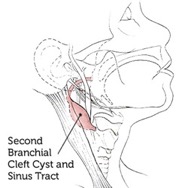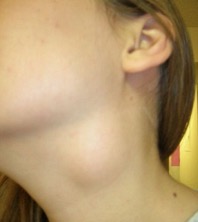Branchial Anomalies
Branchial anomalies occur when there is a problem in the development of face and neck tissues as a baby is being formed within the womb of the mother. The formation of the face and neck structures is complicated in the developing baby. Skin, muscles, bones and cartilage need to form around holes for the eyes, ears and mouth. If problems happen as the face and neck are forming, several things can result.


What symptoms will my child have?
- Cysts are bumps that can be felt under the skin. They may be painless or have pain with swallowing. They can get larger with time.
- Sinuses are also openings in the skin. Since there is no communication to the inside, there is no drainage usually.
- Fistulas present in several locations including in front of the ear or the front part of the neck. Saliva or mucous may drain from the opening. Openings in front of the ear can connect to the ear canal. Openings through the front of the neck can connect to the throat. Fistulas can be on both sides of the neck.
- Rarely, cysts may present as a bump or inflammation of the thyroid with neck tenderness.
- Fistulas, sinuses and cysts may get infected. Less common symptoms include pain with swallowing or ear pain.
What tests will be done to find out what my child has?
- Ultrasound confirms the diagnosis and can usually trace if there is an internal opening (fistula).
- CT or MRI may be needed if there is more information needed or if the diagnosis is not definite.
Are there any conditions that have similar symptoms to branchial anomalies?
- Dermoid cysts: Benign growths under the skin that form from skin elements
- Thyroid nodules: Growths in the thyroid gland
- Lymph nodes: Small nodules in the neck that enlarge in response to infection.
- Skin infections: such as boils or abscesses
How are Branchial Anomalies treated?
If the structure is infected, the infection must be treated first with antibiotics. Sometimes, control of the infection requires draining the pus from underneath the skin.
Surgical removal of the cyst, fistula or sinus is the treatment of choice. The aim of the procedure is to remove the whole cyst without rupture. The operation is performed under general anaesthesia and takes about 30 minutes. You should not have to spend the night in hospital. A cut is made directly over the cyst and it is removed carefully to avoid rupture. The wound is closed with dissolving sutures. Local anaesthetic is injected which will keep the area numb for 6-12 hours after surgery. Waterproof tissue glue is applied as a dressing. It is lilac in colour and takes 2 weeks to fall away.
Preoperative preparation
Your child cannot eat for 6 hours before the procedure. In breast fed babies this time may be reduced by the anaesthetist. Your child can drink water for up to 2 hours before the operation. The Day Surgery Unit will instruct you the day before surgery to confirm fasting times. It is useful to bring your child’s favourite toy along on the day.
Anaesthesia
The anaesthetist will meet you and your child prior to the procedure. They will discuss the anaesthetic with you and take you through to the operating theatre. Your child will be anaesthetised using a face mask and then you will be taken to a waiting area. Once your child is asleep a drip is inserted often in the hand or arm, but occasionally it may need to be sited in the leg.
Initial recovery
On completion of the operation your child will be taken to the recovery area. Children often initially appear distressed and a little confused upon waking up but will quickly settle down once you are with them and if offered a drink or something to eat. Full recovery usually takes about 2-3 hours after which you can go home.
Post-operative course
Children’s paracetamol should be given for pain relief for 24 hours. After that use paracetamol only if needed. Some children need additional medication such as ibuprofen or celecoxib. Opiate (morphine-type) medications are not usually required. Paracetamol and ibuprofen can be given at the same time and work well together. Follow the dosages recommended on the packaging or by the anaesthetist. Never give more than has been prescribed.
It is quite normal for the neck on the side of the operation to look swollen and there may be some bruising. This usually resolves in week or so.
In general, your child may eat a normal diet after surgery. Vomiting is common on the day of surgery. It is temporary, and usually due to the anaesthetic and pain-relief medications that are used. If vomiting occurs, start with clear liquids and add solids slowly for the first day.
Return to activity
- Activity: Your child should avoid strenuous activity first 1-2 days. Sport and swimming are best avoided for 3 weeks after surgery.
- School: Your children may return to day care or school when comfortable.
- Bathing/showering: As the wound is waterproof, bathing and showering is safe after the operation.
- Wound care: No specific wound care is required. The stitches are absorbable and do not require removal. No dressing changes, creams or ointments are required.
- Stool softeners and laxatives: May be needed to help regular stooling after surgery, especially if opiates are needed for pain.
Call the doctor’s office if:
- You notice excessive neck swelling or any shortness of breath. These are serious signs that there is bleeding or swelling that is affecting breathing. You should go directly to your nearest emergency room.
- You see any signs of infection: redness along the incision site, increased swelling, discharge
- Your child’s pain gets worse or is not relieved by pain killers
- There is bleeding from the incision
- Your child has an abnormal temperature
- Vomiting continues on the day after surgery
- If you have any other concerns
Follow-up
I will review your child 4-6 weeks after the surgery to ensure healing of the wound. For patients from rural areas this may be deferred to your local General Practitioner or Paediatrician. Please ring soon after the operation to arrange a convenient time.
Complications
The vast majority of children who have operations to remove branchial remnants recover well and have no serious complications of surgery. Some of the recognised complications of surgery include:
Swelling or bleeding around the airway
This is an immediate post-operative complication and is rare. It can cause difficulty with breathing and may require a trip back to the operating theatre.
Recurrence
There is a small incidence of recurrence (~3%) particularly if there is a history of infection of the branchial remnant.
Infection & Bleeding
As with any surgical procedure there is a 1-2% risk of bleeding or wound infection after surgery. The wound will appear red, be tender to touch and may discharge pus or blood. If this occurs, a course of antibiotics may be required, and you should contact me or present to your General Practitioner or Local Hospital as soon as possible.
Damage to nerves
Branchial anomalies of the face are usually very close to the nerves that control facial movement. Branchial anomalies in the neck are often close to the motor nerve to the tongue and sensory nerves to the throat and occasionally the nerves that control voice. Nerve damage is rare.
Damage to other structures in the neck
Branchial anomalies may course close to blood vessels, the breathing (trachea) and swallowing (oesophagus) tubes and the thyroid and parotid glands. These structures are usually identified and preserved during the operation and damage is rare.
More Information
If you have any questions, please do not hesitate to contact us.
Ph: 02 8307 0977
Fax: 02 8088 7420
Email: info@drgideonsandler.com
Please refer to the following resources for more information:
- Branchial Cleft Cysts and Sinus Tracts
Boston Children's Hospital
This page is intended to provide you with information and does not contain all known facts about branchial anomalies. Treatment may have uncommon risks not discussed here. Please do not hesitate to ask any questions you may have.